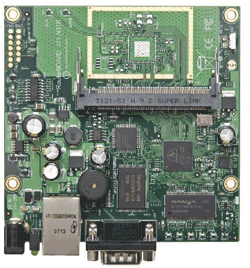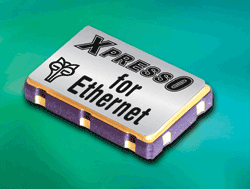Oscillators make big strides in network and mobile apps
BY ROGER BURNS
Engineering Sales Manager
Fox Electronics
www.foxonline.com
As with just about everything else in electronics, product designers are constantly expecting oscillators to get smaller, faster and less expensive all at the same time. For networking and mobile applications, where the demands of end-use applications can approach the extreme limits of the oscillator performance spectrum, production refinements are evolving to keep pace with that demand.
It is not exclusively a case of making the oscillators themselves run “faster” (that is, at a higher reference frequency). Rather, it is a case of delivering oscillators with improved performance characteristics in terms of reduced noise and jitter at any given frequency. That way, jitter issues are not magnified in applications running at a much higher target frequency, such as frequency control for a 10 Gigabit Ethernet network. In mobile applications, it is also a case of balancing all performance characteristics against the ultimate component package size and power consumption.
Higher-speed networks = higher demands
For networking applications, where routine transmission speeds have risen exponentially from 1 Gigabit Ethernet to 10 Gigabit Ethernet (and with even higher rates still being developed), the top three concerns are in order of priority noise, noise, and noise (see Fig. 1 ). And the higher transmission speeds go, the tighter the noise tolerance requirements become, since the noise levels inherent in the oscillator are multiplied as the reference frequency of the oscillator is multiplied to match the network transmission frequency.

Fig. 1: Oscillators developed to counter increased noise from faster transmission speeds must also cope with higher density board architectures. Quieter oscillators must also be significantly smaller to fit in the limited space of smaller devices.
Higher noise levels within the circuit would increase the bit error rate of a device, leading to an increased incidence of lost data packets and a compromise of the total system performance.
Where phase jitter of 1 ps used to be the norm for 1 Gigabit Ethernet applications, designers of 10 Gigabit Ethernet networks are now expecting 0.5- or 0.3-ps performance. Newly redesigned oscillator architectures are evolving to meet the pressures of these and next-generation networking requirements.
An evolving trend for satisfying frequency control requirements in the networking arena is the availability of application-specific oscillator designs configured and characterized for unique reference frequencies targeted by multiple classes of networking applications (see Fig. 2 ). These include separate options for fiber-channel and for Ethernet data transmission networks, SONET optical networks and SATA, SCSI or serial-attached SCSI drives.

Fig. 2: Application-specific oscillators, such as Fox Electronics’ XpressO oscillators for Gigabit Ethernet and 10-Gigabit Ethernet applications, are quickly becoming commonplace. Since the requirements for such applications are fairly standard, oscillators are developed to meet the exact specifications needed.
Since the requirements for each of those applications are well delineated within the industry, oscillators designed and built with pre-determined reference frequencies and application-matched jitter performance make it easier for networking equipment manufacturers to specify and purchase the exact solutions they need, with minimal effort and minimal delivery time.
Increasing mobility demands increasing flexibility
Ever-smaller components are answering demands for lower power consumption in frequency-control solutions that maintain critical timing for everything from personal communications devices to automotive GPS systems and industrial applications.
For handheld devices where every gram of battery weight is critical, oscillator design enhancements have reduced input current requirements from 15 to 20 mA down to 2 or 3 mA, and with as little as 5 µA standby current. Yet they provide electronic device designers with frequency stability of 20 ppm or better — at frequencies from 1 MHz to greater than 50 MHz — in packages as small as 2.5 x 2.0 mm.
Oscillator capabilities in those ranges satisfy numerous portable and battery-powered device requirements including for satellite or terrestrial radio, GPS and WiMAX, 802.11, or Bluetooth wireless (see Fig. 3 ). And, because of low heat emissions related to their low power consumption, these oscillators are well suited for applications with minimal air circulation, such as compact consumer electronics and weather-proof enclosures.

Fig. 3: Evolving technology has made small, portable, battery-powered devices (such as e-readers) increase highly in demand.
In more strenuous applications, however, the durability to withstand shock, vibration and extended temperature ranges can become as critical as device size or power consumption. For these applications, automotive-grade crystals mounted for shock-resistant, vibration-resistant performance provide precise timing where oscillator configurations cannot withstand the necessary level of durability. Crystals manufactured to meet AEC-Q200 Stress Test Qualification for Passive Component requirements are available in 2.5 x 2.0-mm package sizes, with reference frequencies to 50 MHz and operating temperatures from –40° to 125°C.
Such automotive-grade crystals can be employed in applications ranging from navigation systems to high-end audio and video systems, collision warning systems, antilock braking system (ABS) control and other automotive on-board computer systems. Off-highway applications for the same automotive-grade crystals can include GPS navigation systems in heavy-duty construction equipment.
Mobile electronics for industrial environments also utilize these same automotive-grade crystals for applications where the likelihood of equipment being used roughly, bumped or dropped onto hard surfaces is high. They include wireless meter-reading devices, data devices used by package delivery services and portable barcode scanners used in warehouse inventory management systems.
Oscillator technology: Changing to keep pace with changing demands
A significant factor that has eased previously conflicting aspects of oscillator performance vs. noise vs. delivery lead-time across many application areas in recent years has been the industry acceptance of a modular building-block architecture.
This technology complements conventional oscillator crystal blanks with special circuitry to deliver a specific reference frequency with the desired noise reduction. One of several fractional-N phase-locked loops (PLLs) is applied and third-order delta-sigma modulator (DSM) technology is used to lower the overall amplitude of spurs by spreading them over a larger bandwidth. By combining these features with application-specific integrated circuits (ASICs), this modular approach allows for accurate performance with lower noise and jitter characteristics.
Best of all, this technology delivers the performance to satisfy escalating requirements of equipment manufacturers with reduced component lead times and reduced costs. The latest generation of this technology holds promise for reduced jitter (in the range of 0.3 to 0.5 ps), expanded frequency ranges up to 1.5 GHz, voltage requirements down to 1.8 V, plus better phase noise to meet OC-192 requirements.
As smaller and faster is still the demand in the overall electronics industry, oscillator manufacturers continue to develop new technologies that provide performance characteristics that meet the industry demands, coupled with better delivery and low-cost solutions. ■
Fig. 2: Application-specific oscillators, such as Fox Electronics’ XpressO oscillators for Gigabit Ethernet and 10-Gigabit Ethernet applications, are quickly becoming commonplace. Since the requirements for such applications are fairly standard, oscillators are developed to meet the exact specifications needed. Fig. 3: Evolving technology has made small, portable, battery-powered devices (such as e-readers) increase highly in demand.
Advertisement
Learn more about Fox Electronics





